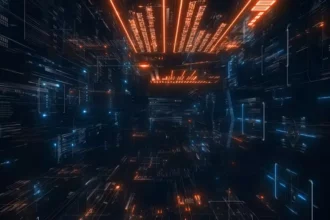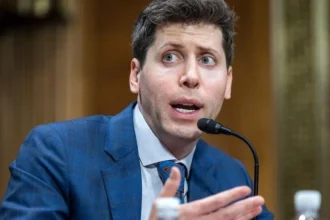Table of Contents
ToggleInside Hollywood’s AI Power Struggle: Where Does Human Creativity Go From Here?
Hollywood faces a heated battle over AI’s role in creativity, balancing innovation and preserving human artistry. This conflict plays out in festivals, studios, and courts, shaping the industry’s future and possibly every creative field.
Film Festivals and AI: A Fraught Relationship
Film festivals initially show curiosity toward AI-infused works. Audiences remark they find such films “interesting” and “creative,” appreciating the fresh storytelling approach. Yet, controversy arises when credits reveal a blend of AI and human creativity. Some viewers react negatively, expressing concern over AI’s influence on artistry.
Festivals enforce strict guidelines on AI use. Many submissions are rejected for relying heavily on AI to generate entire films, violating festival rules designed to ensure substantial human involvement.
Filmmakers face ethical dilemmas. Those with limited budgets may find AI tools essential to telling their stories, but questions remain about fairness. Should AI be a shortcut or a supplement to traditional creativity?
The Rise of AI in Creative Software
Creative software has integrated AI extensively. Programs like Photoshop and video editors now feature AI-driven tools that automate complex tasks. These updates speed up workflows and allow users with basic skills to produce higher-quality content quickly.
Text-to-image AI generators have become popular. They convert textual prompts into artistic visuals, ranging widely in quality. This technology democratizes art creation but also stirs debate over originality and authorship.
Hollywood’s AI Power Struggle: Diverse Perspectives
Within the entertainment industry, opinions on AI vary sharply. Some champion it as a way to optimize creativity and efficiency. Others warn it threatens to end human artistry or lead to unethical practices.
The adoption of AI is complex. Major studios might embrace it fully, while others delay due to unresolved legal questions. AI’s dual role—as a cost-saving tool and a potential source of long-term issues—adds tension to decision-making.
Hollywood’s choices will inevitably impact all creative sectors. The power and reach of its industry set standards for AI’s acceptable role in artistic productions worldwide.
AI in Filmmaking: Accessibility and Limitations
Generative AI lowers traditional barriers to filmmaking, such as budget and technical expertise. Anyone can experiment with digital content creation more affordably and easily.
AI video generators now enable creation of short clips from text or images. However, current technology limits output to brief segments, typically 5 to 10 seconds, lacking integrated audio, which restricts professional use.
Video editing software incorporates generative AI, blurring distinctions between manual edits and AI modifications. This fusion raises questions about authenticity and creator credit.
Hollywood Embraces AI: From Suspicion to Integration
Entertainment leaders explore AI adoption primarily to cut costs. Director James Cameron highlights AI’s potential to speed production, not to reduce workforce size.
Smaller filmmakers and amateurs benefit from AI’s efficiency, enabling projects otherwise unaffordable.
Notably, actress-director Natasha Lyonne’s new sci-fi film partners with an AI production studio using “clean” AI models, emphasizing ethical AI development.
Films like “The Brutalist” showcase AI in postproduction, using generative voice technology to enhance actors’ foreign-language dialogues, sparking debate on creative integrity.
The Academy and Emmy rules reflect cautious acceptance, judging AI-edited content case-by-case without bias.
Major studios like Lionsgate collaborate with AI companies such as Runway to develop proprietary AI models, unlocking new creative tools from extensive film libraries.
Challenges: Legal and Ethical Concerns
Legal battles loom large, with over 30 active copyright lawsuits accusing AI firms of unauthorized use of creator content. Plaintiffs claim AI outputs infringe intellectual property rights.
Studios remain wary, understanding that AI’s promise comes with significant unresolved legal and ethical issues.
Key Takeaways
- Hollywood’s embrace of AI sparks debate over the future of human creativity and artistic standards.
- Film festivals enforce limits on AI-generated content to preserve human involvement.
- AI integration in creative tools lowers entry barriers but raises ownership and quality questions.
- AI offers cost-saving opportunities yet triggers fear of job losses and originality loss.
- Legal challenges over AI and copyright create uncertainty for entertainment companies.
- Industry decisions will influence global norms on AI’s role in creative work.
Inside Hollywood’s AI Power Struggle: Where Does Human Creativity Go From Here?
Hollywood today faces a fierce battle over artificial intelligence, shaking the very core of human creativity in film and entertainment. At a time when AI-powered tools are rewriting the rules, the industry is split between embracing AI’s promise and protecting the authentic human touch. So, what does this mean for creators and audiences alike? Let’s dive into this tangled story to uncover the implications and future paths.
Imagine attending a film festival. A new film screens, stunning viewers with captivating imagery and storytelling. Yet, after the credits roll, a shocking reveal causes a scene: “This film is a blend of artificial intelligence and human creativity.” Suddenly, cheers turn to boos. This real-life moment captures the growing tension around AI’s role in filmmaking.
Film festivals, traditionally safe havens for human artistry, now wrestle with policies on AI. Many outright reject submissions where AI serves as the primary creator. Why? Festival directors and audiences alike question: Is it fair? Does it dilute artistic expression? And what about filmmakers who lack resources for expensive software or teams? Must they turn to AI to even tell their stories?
The Rise of AI in Creative Software
AI is no longer a futuristic concept; it’s a working part of mainstream creative software. Programs like Photoshop and various video editors now boast AI-powered tools that streamline work or generate content. But AI image generators, operating on simple text inputs called “prompts,” have sparked both amazement and skepticism. Some outputs range from breathtaking art to inexplicable nonsense. The accessibility is incredible, yet the quality and originality can vary wildly.
This invites a question: When does AI’s assistance cross into appropriation or creative laziness? Studios are pondering this deeply.
The AI Power Struggle Intensifies in Hollywood
In Hollywood’s corridors, AI stirs fierce debates. Some hail AI as a new tool to optimize workflows, slash costs, and unleash fresh creativity. Others fear AI threatens the essence of human imagination and jobs. This conflict is anything but black and white. The industry’s ecosystem is a complicated mix of studios eager to adopt AI, networks balancing regulation, creative unions fearful of job losses, and independent creators longing for inclusion.
Economic pressures fuel this tussle. Films’ rising production costs and a talent crunch push studios to consider AI as a remedy or risk. Think of AI both as a fix and a threat—one that might reshape Hollywood permanently. Every decision made today on AI usage will echo across creative industries worldwide, influencing what stories get told and how audiences experience them.
How AI Fits into Filmmaking: Accessibility Meets Limitations
One powerful argument for AI is democratization. Costs, skills, and education barriers that once blocked many aspiring filmmakers are lowering. AI tools enable easier creation of digital content. For example, today’s AI video generators can turn simple text or images into short video clips. However, these clips typically last only five to ten seconds and often lack native audio, limiting professional applications.
This technology is fast evolving, yet current AI video models still wrestle with quirks like incomplete audio support and restricted clip lengths. Meanwhile, generative AI embedded in video editors blurs lines between human creativity and machine assistance. Filmmakers now ask: How much AI is too much before the human fingerprint fades?
The Role of AI: From Villain to Cast Member
Despite technical hurdles, leaders in entertainment actively explore AI’s advantages. For studios, the lure is clear: save money and enhance production efficiency. Legendary director James Cameron’s vision exemplifies this balance. He supports using AI to cut visual effects costs in half—not by replacing workers, but by boosting their speed and creativity.
Smaller productions and amateurs already embrace AI for cost-saving and workflow gains. Meanwhile, some celebrities are championing AI partnerships. Natasha Lyonne’s sci-fi directorial debut involves her AI production studio, Asteria, employing so-called “clean” AI models to ensure ethical standards.
Yet controversies arise. Take the case of The Brutalist, where AI voice technology enhanced actor Adrien Brody’s Hungarian dialogue to save time and money. This sparked backlash about the authenticity of performances and the role of AI in post-production.
Industry institutions cautiously adapt. The Academy of Motion Picture Arts and Sciences declared AI use neither boosts nor diminishes chances for awards, while the Emmys judge AI work on a case-by-case basis. Meanwhile, partnerships like Lionsgate and Runway highlight how studios create proprietary AI models using vast media catalogs, signaling AI’s growing foothold.
Legal and Ethical Minefields: Copyright Concerns
Hollywood’s AI rush encounters serious legal battles. Over 30 copyright lawsuits target AI firms accused of training models on stolen creator content. These cases claim AI-generated outputs imitate copyrighted work too closely, infringing intellectual property rights. The outcomes will shape how studios, creators, and AI companies navigate this fast-moving frontier.
Ethically, the debate includes fairness. Should filmmakers with less money rely on AI and risk festival disqualification? Do AI tools level the playing field or create new forms of gatekeeping disguised as innovation?
Where Does Human Creativity Go from Here?
Here’s the million-dollar question: Will human creativity become obsolete or evolve alongside AI? History suggests technologies change art but rarely erase human expression. From the first cameras to digital editing, new tools forge new possibilities. AI’s rise feels different because it can automate creative processes, but it also offers novel avenues for storytellers.
One pragmatic approach is blending human ingenuity with AI efficiency—keeping humans at the creative helm while letting AI shoulder repetitive or technical tasks. This symbiosis can unlock faster innovation and reduce costs while preserving authenticity.
Hollywood must strike a balance—embracing AI without letting it erode the soul of storytelling. Ethical guidelines, transparent AI disclosures, and fair industry standards could protect creators and inspire audiences. The debate need not be a battle where one side wins and the other loses but rather a dialogue that advances creative possibilities.
Practical Takeaways for Creators and Viewers
- For Creators: Experiment with AI tools while maintaining your unique vision. Use AI to enhance, not replace, your creative decisions.
- For Independent Filmmakers: Leverage AI accessibility but be aware of festival rules and ethical considerations. Transparency builds trust.
- For Studios: Invest in training and clear policies that protect jobs and intellectual property.
- For Audiences: Be curious but critical about AI’s presence in entertainment. Support works where human creativity shines alongside AI innovation.
Hollywood’s AI story is still unfolding—filled with promise, challenges, controversy, and transformation. Whose creativity will prevail? Likely, the future belongs to those who understand and shape AI without losing the human heart at the center of storytelling.
“AI is neither the end of creativity nor its savior. It is a tool whose impact depends on how wisely we wield it.”
How are film festivals handling movies created with AI?
Many festivals reject films made entirely by AI. They often require transparency about AI use. Audience reactions vary, with some appreciating innovation while others object to AI blending.
What limits does current AI technology have in filmmaking?
AI video generators typically produce very short clips, often without native audio. This limits their use for professional projects needing longer scenes and sound integration.
Why are some Hollywood studios cautious about adopting AI?
Studios face legal and ethical concerns, plus worries over copyright lawsuits. They also debate whether AI might reduce human creativity or harm industry jobs.
How might AI change opportunities for smaller filmmakers?
AI lowers cost and skill barriers, allowing indie creators and amateurs to produce digital content more easily. It helps them work with fewer resources.
What impact will Hollywood’s AI decisions have on the broader creative industry?
Hollywood sets standards. How it integrates AI will influence what is accepted in movies and TV. This affects creators and viewers across many fields worldwide.



